超级相机的火星标的
See Explanation. Clicking on the picture will download the highest resolution version available.
请参阅说明。单击图片将下载可用的最高分辨率版本。

See Explanation. Clicking on the picture will download the highest resolution version available.
请参阅说明。单击图片将下载可用的最高分辨率版本。
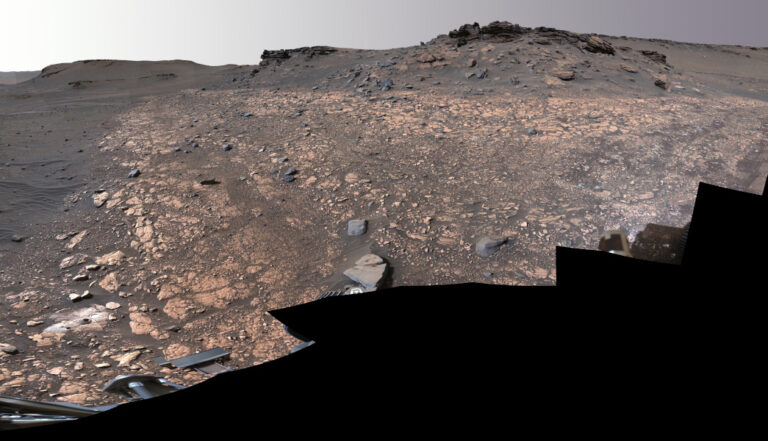
2022年9月17日 Perseverance in Jezero Crater’s Delta Image Credit: NASA, JPL-Caltech, MSSS, ASU Explanation: The Perseverance rover’s Mastcam-Z captured images to create this mosaic on August 4, 2022. The car-sized robot was continuing its exploration of the fan-shaped delta of a river that, billions of years ago, flowed into Jezero Crater on Mars. Sedimentary rocks preserved in Jezero’s delta are considered one of the best places on Mars to search for potential signs of ancient microbial life and sites recently sampled by the rover, dubbed Wildcat Ridge and Skinner Ridge, are at lower left and upper right in the frame. The samples taken from these areas were sealed inside ultra-clean sample tubes, ultimately intended for return to Earth by future missions. Starting with the Pathfinder Mission…
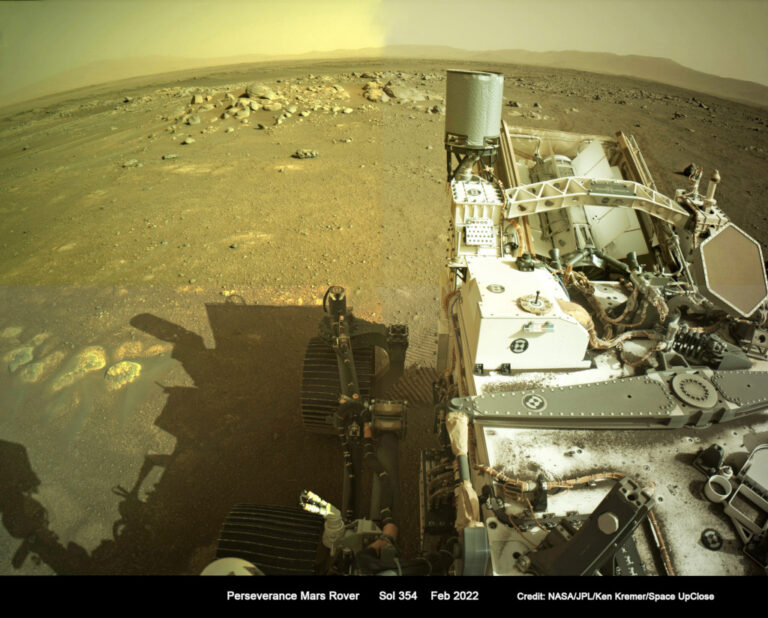
2022年2月25日 Perseverance Sol 354 Image Credit: NASA, JPL-Caltech, Processing: Kenneth Kremer Explanation: This Navcam mosaic from Perseverance looks out over the car-sized rover’s deck, across the floor of Jezero crater on Mars. Frames used to construct the mosaic view were captured on mission sol 354. That corresponds to Earth calendar date February 17, 2022, nearly one Earth year after the rover’s landing. With a mass of over 1,000 kilograms, six-wheeled Perseverance is the heaviest rover to touch down on Mars. During its first year of exploration the rover has collected six (so far) rock core samples for later return to planet Earth, served as the base station for Ingenuity, the first helicopter on Mars, and tested MOXIE (Mars Oxygen In-Situ Resource Utilization Experiment), converting some…
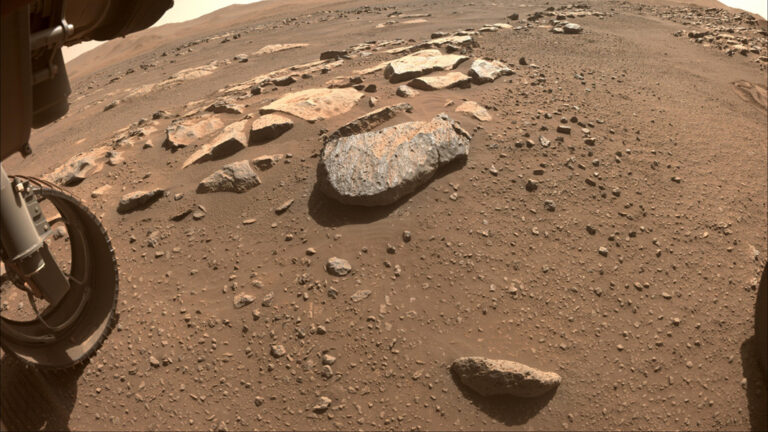
2021年8月28日 Mars Rock Rochette Image Credit: NASA, JPL-Caltech Explanation: Taken on mission sol 180 (August 22) this sharp image from a Hazard Camera on the Perseverance rover looks out across a rock strewn floor of Jezero crater on Mars. At 52.5 centimeters (21 inches) in diameter, one of the rover’s steerable front wheels is at lower left in the frame. Near center is a large rock nicknamed Rochette. Mission planners don’t want to avoid Rochette though. Instead Perseverance will be instructed to reach out with its 2 meter long robotic arm and abrade the rock’s surface, to determine whether it has a consistency suitable for obtaining a sample, slightly thicker than a pencil, using the rover’s coring bit. Samples collected by Perseverance would be returned…
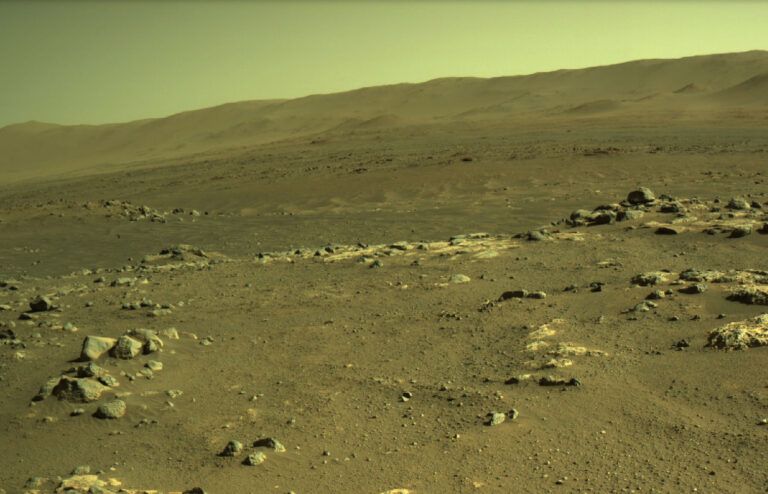
毅力号火星车用它的导航摄像机拍摄到了这张俯瞰塞塔(Séítah)地区的照片。7月5日,机智号直升机在第九次飞行中飞越了该地区。 资料来源:NASA/JPL-Caltech 这一周,火星直升机团队的忧虑加剧,因为我们为机智号准备了一次重大的飞行挑战。这次飞行发生在太平洋时间7月5日星期一凌晨2点03分,我们上传了飞行指令,然后紧张地等待当天早上晚些时候从火星发回的结果。当我们得知机智号在完成跨越2051英尺(625米)挑战性地形的旅程后,地面控制室里的人都兴高采烈。 第9次飞行与之前的飞行不同。它打破了我们在飞行时间和巡航速度方面的记录,而且在两个机场之间的飞行距离几乎翻了四倍。但真正使这次飞行与众不同的是机智号在2分46秒的空中飞行中必须经过的地形——一个被称为塞塔的地区,用像毅力号火星车这样的地面交通工具很难通过。这次飞行也被明确地设计为具有科学价值,通过提供第一次近距离观察漫游者将在相当长一段时间内无法到达的主要科学目标。 这张地图显示了NASA的机智号直升机在7月5日第9次飞行期间的大致飞行路径。 图片来源:NASA/JPL-Caltech 睁着眼睛飞行 在之前的每一次飞行中,机智号都是从一个机场跳到另一个机场,飞越的是大致平坦的地形。在计划飞行时,我们甚至小心地避免飞越火山口。我们首先进入一个看起来像被严重侵蚀的火山口,然后沿着斜坡和起伏的地形继续下降,然后再次爬升,出现在西南方向的平坦平原上。 地地形的细节对于在空中飞行的车辆来说似乎很奇怪,因为它们很重要。原因与机智号的导航系统和它最初的设计有关:在一个精心选择的实验测试地点进行简短的技术演示。 当我们人类看地面的移动图像时,比如机智号的导航相机所拍摄的图像,我们马上就能很好地理解我们看到的是什么。我们看到岩石和波纹、阴影和纹理,地形的起伏也相对明显。然而,机智号并没有人类对其所看到的事物的感知和理解。它以个体的、匿名的特征(本质上是随时间移动的点)来看待世界,并试图解释这些点的移动。 为了让这项工作更轻松,我们给机智号的导航算法一些帮助:我们告诉它,这些特征都位于平坦的地面上。这就使算法不用再去计算地形高度的变化,而使其能够专注于仅通过直升机的运动来解释特征的运动。但是,如果我们试图飞越并非真正平坦的地形,就会出现复杂的情况。 地形高度的差异会导致特征以不同的速率在视野中移动,而机智号的导航算法仍然“假定”下方的地面是平坦的。它尽量通过直升机运动的变化来解释地物的移动,这可能会导致错误。最重要的是,它可能导致错误的估计航向,从而导致直升机向与预期不同的方向飞行。 为颠簸的飞行做准备 地面平坦的假设被纳入算法的设计中,我们在计划飞行时对此无能为力。我们能做的是预测由于这种假设而出现的问题,并在我们计划飞行的方式和我们给软件的参数方面尽可能地减少这些问题。 我们使用模拟工具,使我们能够在执行飞行之前详细研究飞行的可能结果。对于第9次飞行,飞行计划的一个关键调整是在我们进入火山口的关键时刻降低我们的速度。尽管这样做的代价是延长了飞行时间,但它有助于减少早期的航向错误,因为这些错误可能会发展成一个大的跨航迹位置错误。我们还调整了导航算法的一些细节参数,这些参数是我们在以前的飞行中至今没有接触过的。而且我们划出了一个比以前的飞行大得多的机场,半径为164英尺(50米)。我们最终在离该机场中心约154英尺(47米)的地方着陆。 在接下来的一周,机智号将会发回毅力号的科学家们期待研究的彩色图像。在这些图片中捕捉到的岩石露头显示了杰泽罗陨石坑底部主要地质单元之间的接触。其中还包括一个被毅力号团队称为“凸起脊”的断裂系统,火星车的科学家希望访问这个系统,以调查那里是否可能保存着一个古老的地下栖息地。 最后,我们希望这些彩色图像能让我们更近距离地观察“Pilot Pinnacle”,这个地方有一些露头(岩石露出地面的部分),一些团队成员认为可能记录了古老的杰泽罗湖中一些最深的水环境。考虑到任务安排的紧凑,他们可能无法与火星车一起访问这些岩石,所以机智号可能会提供唯一的机会来详细研究这些沉积物。 参考来源: https://mars.nasa.gov/technology/helicopter/status/314/flight-9-was-a-nail-biter-but-ingenuity-came-through-with-flying-colors/
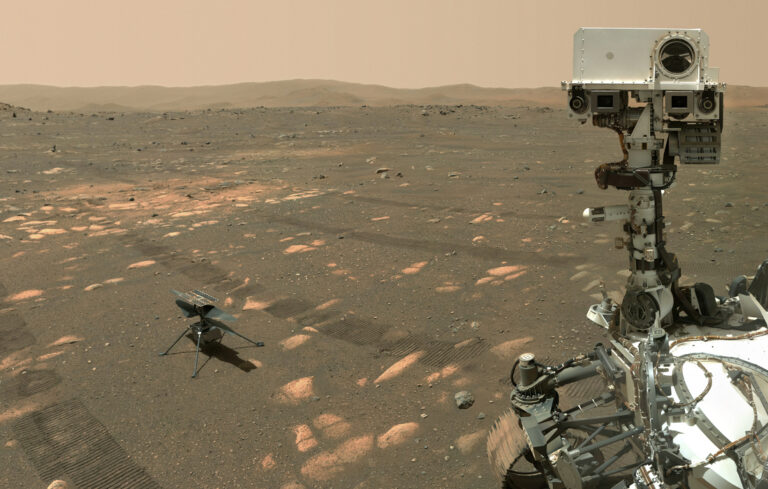
2021年07月01日 Perseverance Selfie with Ingenuity Image Credit: NASA, JPL-Caltech, MSSS Explanation: On sol 46 (April 6, 2021) the Perseverance rover held out a robotic arm to take its first selfie on Mars. The WATSON camera at the end of the arm was designed to take close-ups of martian rocks and surface details though, and not a quick snap shot of friends and smiling faces. In the end, teamwork and weeks of planning on Mars time was required to program a complex series of exposures and camera motions to include Perseverance and its surroundings. The resulting 62 frames were composed into a detailed mosiac, one of the most complicated Mars rover selfies ever taken. In this version of the selfie, the rover’s Mastcam-Z and SuperCam instruments…

2021年04月20日 Ingenuity: First Flight over Mars Video Credit: NASA, JPL-Caltech, ASU, MSSS Explanation: What’s the best way to explore Mars? Perhaps there is no single best way, but a newly demonstrated method shows tremendous promise: flight. Powered flight has the promise to search vast regions and scout out particularly interesting areas for more detailed investigation. Yesterday, for the first time, powered flight was demonstrated on Mars by a small helicopter named Ingenuity. In the featured video, Ingenuity is first imaged by the Perseverance rover sitting quietly on the Martian surface. After a few seconds, Ingenuity’s long rotors begin to spin, and a few seconds after that — history is made as Ingenuity actually takes off, hovers for a few seconds, and then lands safely. More…

2021年03月13日 SuperCam Target on Ma’az Image Credit: NASA/JPL-Caltech/LANL/CNES/CNRS Explanation: What’s the sound of one laser zapping? There’s no need to consult a Zen master to find out, just listen to the first acoustic recording of laser shots on Mars. On Perseverance mission sol 12 (March 2) the SuperCam instrument atop the rover’s mast zapped a rock dubbed Ma’az 30 times from a range of about 3.1 meters. Its microphone recorded the soft staccato popping sounds of the rapid series of SuperCam laser zaps. Shockwaves created in the thin martian atmosphere as bits of rock are vaporized by the laser shots make the popping sounds, sounds that offer clues to the physical structure of the target. This SuperCam close-up of the Ma’az target region is 6…
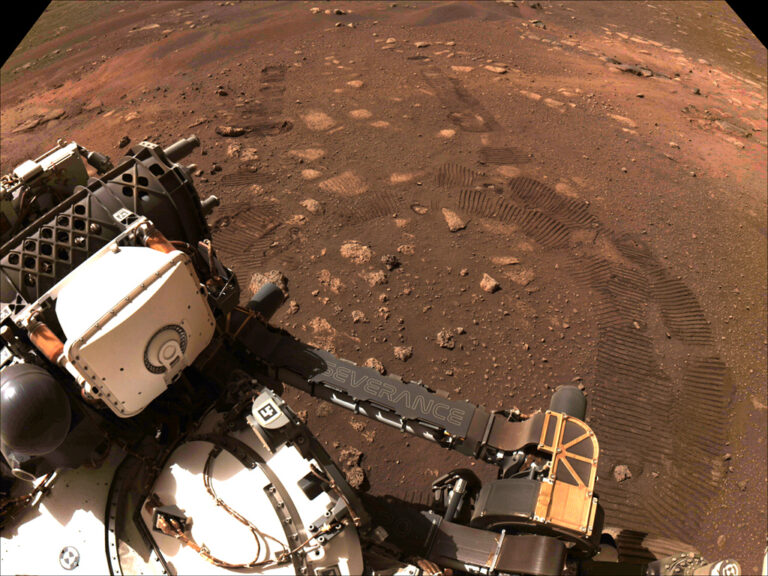
2021年03月06日 Perseverance Takes a Spin Image Credit: NASA, JPL-Caltech, Mars 2020 Explanation: After arriving at Jezero Crater on Mars, Perseverance went for a spin on March 4. This sharp image from the car-sized rover’s Navcam shows tracks left by its six wheels in the martian soil. In preparation for operations on the surface of the Red Planet, its first drive lasted about 33 minutes. On a short and successful test drive Perseverance moved forward 4 meters, made a 150 degree turn in place, backed up for 2.5 meters, and now occupies a different parking space at its newly christened Octavia E. Butler Landing location. Though the total travel distance of the rover’s first outing was about 6.5 meters (21 feet), regular commutes of 200 meters…

2021年03月02日 Ingenuity: A Mini-Helicopter Now on Mars Illustration Credit: NASA, JPL-Caltech, Mars 2020 – Perseverance Explanation: What if you could fly around Mars? NASA may have achieved that capability last month with the landing of Perseverance, a rover which included a small flight-worthy companion called Ingenuity, nicknamed Ginny. Even though Ginny is small — a toaster-sized helicopter with four long legs and two even-longer (1.2-meter) rotors, she is the first of her kind — there has never been anything like her before. After being deployed, possibly in April, the car-sized Perseverance (“Percy”) will back away to give Ginny ample room to attempt her unprecedented first flight. In the featured artistic illustration, Ginny’s long rotors are depicted giving her the lift she needs to fly into…